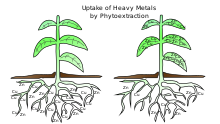
Phytomining, sometimes called agromining,[1] is the concept of extracting heavy metals from the soil using plants.[2] Specifically, phytomining is for the purpose of economic gain.[3] The approach exploits the existence of hyperaccumulators, proteins or compounds secreted by plants to bind certain metal ions. These extracted ores are called bio-ores.[4] A 2021 review concluded that the commercial viability of phytomining was "limited"[1] because it is a slow and inefficient process.
History
[edit]Phytomining was first proposed in 1983 by Rufus Chaney, a USDA agronomist.[5] He and Alan Baker, a University of Melbourne professor, first tested it in 1996.[5] They, as well as Jay Scott Angle and Yin-Ming Li, filed a patent on the process in 1995 which expired in 2015.[6]
Advantages
[edit]Phytomining would in principle cause minimal environmental effects compared to mining.[2] Phytomining could also remove low-grade heavy metals from mine waste.[4]
See also
[edit]References
[edit]- ^ a b Dang, P.; Li, C. (2022-12-01). "A mini-review of phytomining". International Journal of Environmental Science and Technology. 19 (12): 12825–12838. Bibcode:2022JEST...1912825D. doi:10.1007/s13762-021-03807-z. ISSN 1735-2630.
- ^ a b Brooks, Robert R; Chambers, Michael F; Nicks, Larry J; Robinson, Brett H (1998-09-01). "Phytomining". Trends in Plant Science. 3 (9): 359–362. Bibcode:1998TPS.....3..359B. doi:10.1016/S1360-1385(98)01283-7. ISSN 1360-1385.
- ^ Linacre, J. Scott Angle and Nicholas A. (2005). Ecological Risks of Novel Environmental Crop Technologies Using Phytoremediation as an Example. Intl Food Policy Res Inst.
- ^ a b "Leaders of the energy transition are calling for a sustainable source of critical metals – is phytomining the answer?". smi.uq.edu.au. 2021-02-11. Retrieved 2023-10-09.
- ^ a b Morse, Ian (2020-02-26). "Down on the Farm That Harvests Metal From Plants". The New York Times. ISSN 0362-4331. Retrieved 2023-10-09.
- ^ US5711784A, Chaney, Rufus L.; Angle, Jay Scott & Baker, Alan J. M. et al., "Method for phytomining of nickel, cobalt and other metals from soil", issued 1998-01-27
Well, that’s interesting to know that Psilotum nudum are known as whisk ferns. Psilotum nudum is the commoner species of the two. While the P. flaccidum is a rare species and is found in the tropical islands. Both the species are usually epiphytic in habit and grow upon tree ferns. These species may also be terrestrial and grow in humus or in the crevices of the rocks.
View the detailed Guide of Psilotum nudum: Detailed Study Of Psilotum Nudum (Whisk Fern), Classification, Anatomy, Reproduction